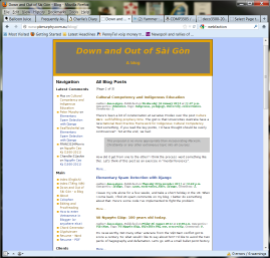Posted by: pkmurphy 11 years, 8 months ago
Note: this was the first blog post written for DECO7350, but the date was changed to make it into the master feed for the subject. The link "This is DECO7350!" originally referred to the URL "http://deco7350.pkmurphy.com.au/". That website has been taken down, and its blog posts have been gathered here.
Since this post was written, Larvatus Prodeo has come back to life. That's good to see.
There are many blogging engines on the World Wide Web; examples include Wordpress, Movable Type, Blogger, and Typepad. For this post, I would rather analyse "ideal blogs" (analogous to physicists studying "ideal gases") rather than concentrate on a particular implementation. I've used three of them myself: a moribund Blogger account from when I was in Việt Nam, one I built from Django for my personal site using the Django web framework, and finally the one you are reading now: This is DECO7350! My experience tells me that the differences are not as important as the similarities, so let's concentrate on those. So what do I consider are the essential qualities of an "ideal blog"?
- Software allowing users to write content for web pages, without worrying about boilerplate HTML like "<head>".
- A templating system that wraps the boilerplate around the content, generally using a common style for the blog.
- An address for each post, plus addresses for derived content: listings of posts via month/year, tags, and other metadata. The home page, generally with an address of "/", is another example of a listing page; standard practice is to present the latest posts in reverse chronological order.
- A commenting system where commenters can give their feedback. More will be said below on this matter.

An example of another blog. You are reading this on a blog, are you not?
There are other commonalities - like RSS/Atom feeds - but those four features will do. One thing about blogs is that writers don't generally delete individual posts, except when embarassed or possibly under threat of a defamation suit. Blogs score high on persistance, and the addresses assigned to posts may be valid for months or years. It is more common for whole blogs to disappear than individual posts; people commit infosuicide, and sometimes the relevant ISP goes under or the blogger forgot to pay the bills. But even if blogs remain to be fetched on the world wide web, that doesn't mean they're alive. Sometimes, a conscious decision is made to stop posting altogether, as what happened with Brisbane political blog Larvatus Prodeo. Other writers lose motivation, stop writing, and leave behind an unremembered blog on Wordpress or Blogger.
Where does blogging fall in the "Groupware Time-Space Matrix"? Blogging is a distributed activity, in that bloggers are not required to be in the same place – let alone the same country – as their readers or commenters. Blogging is also asynchronous, as it may be hours or days before their posts are read. But it is not completely asynchronous, because once a post goes beyond a week in age, most readers lose interest. It's not so interesting when the blogger has popped out fresher posts in the interim, possibly displacing the leading post from the home page in the process.
Conversation is an interesting issue for blogging. It happens between bloggers; one writer links to another writer's post and add their own insights and critique. More commonly, it happens between bloggers and the commenters that come to visit and read. But this implies that the blogging engine has a commenting system attached – and not all did in the past. For example, Blogger, which was created in 1999, didn't add its own native commenting system until 2004. My point is that commenting was seen as an interesting feature to have, rather than an essential requirement as it is now – and many of the consequences were not anticipated.
Some blogs fell prey to comment spam like livers to Ebola; others became unreadable as their comments became infested with trolls. But many survived, and those that did were generally the ones where the blogger involved maintained the comments "like a garden". Let the flowers grow, but remove the weeds of trolls and spammers. So now a third type of conversation developed: commenter to commenter. We find it is possible to two individuals to talk decently to each other through the medium of pure text, even with all the visual and aural cues absent. But there is more motivation to be gentle and kind if the host is ready and willing to wield the banhammer on miscreants.
Share on Twitter Share on Facebook
Recent Posts
- An email to multilevel marketeers
- The Slide Rule - hand held computation before there were hand held computers
- A not so small Foursquare review
- Stack Overflow – social media brilliance for the working programmer
- Scanner Radio
Archive
2013
- April (1)
2012
2011
2010
Tags
- blog (1)
- United States (2)
- web (1)
- marketing (1)
- Politics (2)
- Scams (1)
- DECO7350 (10)
- Personal (1)
- English (3)
- Kevin Rudd (1)
- Julia Gillard (1)
- ALP (1)
- Australia (1)
- Pollution (1)
- Education (2)
- Việt Nam (2)
- Training (1)
- Foreclosure (1)
- crisis (1)
- housing (1)
- fraud (1)
- Various (1)
- ghostwriting (1)
- scam (1)
- scumminess (1)
Authors
- pkmurphy (16)